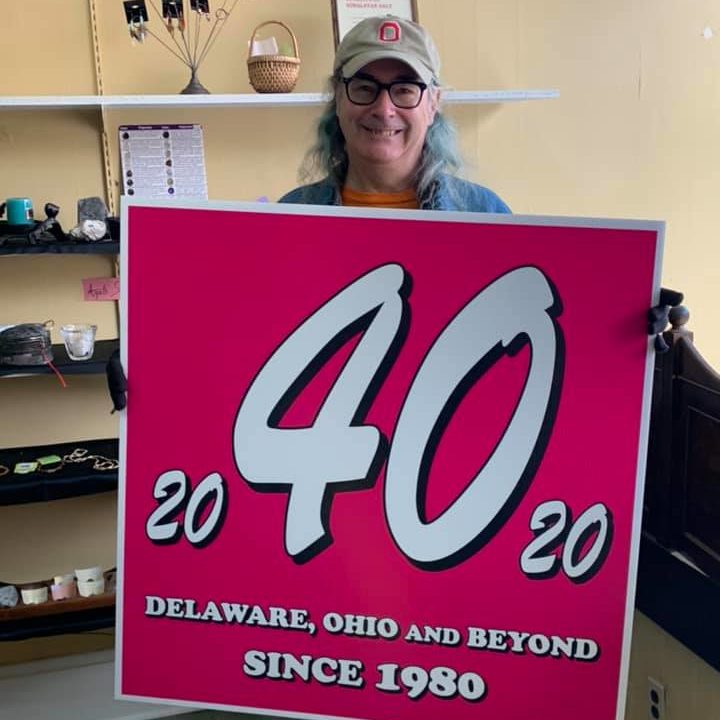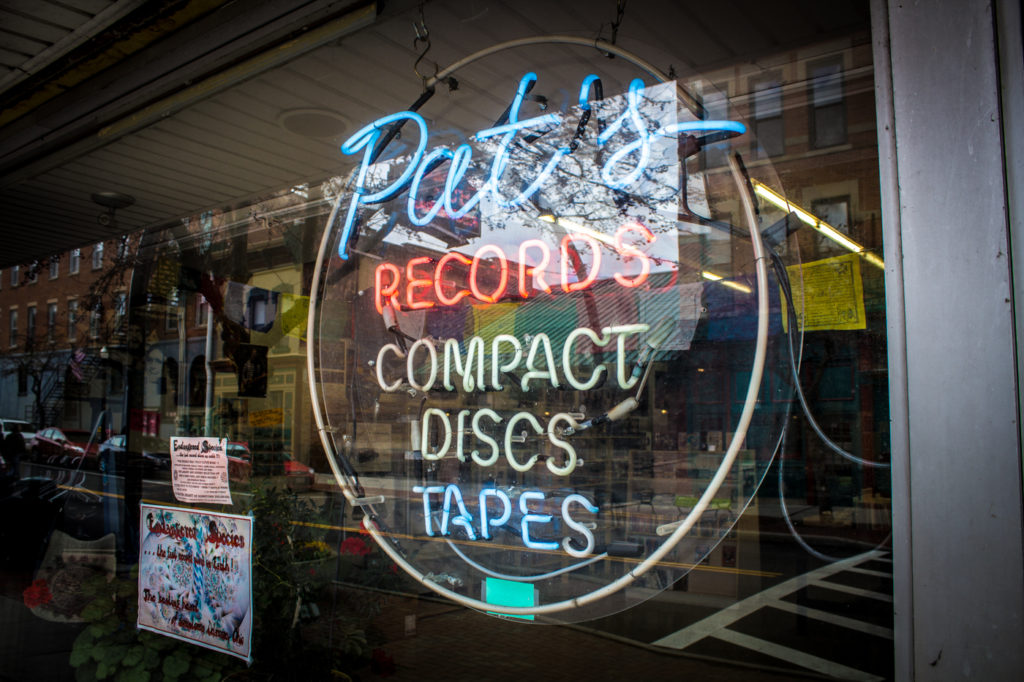

Pat's Endangered Species - The Last Record Store on Earth
By Keith Flint, soyconguero@gmail.com
Walking along Winter Street in downtown Delaware on a sultry August afternoon, my attention is drawn to the faint sounds of “Moanin’” by Art Blakey and the Jazz Messengers. The song stops me dead in my tracks. I’m mesmerized. And I’m transported back to a time when, trumpet in hand, I’m playing with my high school jazz band’s horn section. It’s Lynn Gossett, Mark Andrews, Molly Perkins, Sue Stephan, and me. We are collectively poised to impress our peers. It’s 1975 and I’m already soaking through my polyester shirt as the spotlight hits our corner of the stage… Then I snap back to reality with feet firmly planted on the sidewalk in front of Pat’s Endangered Species—The Last Record Store on Earth. I push open the door, feel the music wash over me, and I wonder: How lucky am I? This source of endearing memories and wellspring of unfettered joy is located just down the street from my house. Do my neighbors realize what treasure we have within walking distance of our homes? Then I take those musings a step further into the municipality at-large. What defines a community? What makes us feel at home? Is it our neighbors? The people who live and work here? Does that assemblage include the visitors we now attract from the surrounding area? Or is it about the spaces we chose to inhabit? Arguably, it’s the nexus of it all. And it is up to us to define it, admire it, and nurture it together.
Pat’s provides one such social hub. It has been a fixture of the Delaware community for an unimaginable 40 years. That is remarkable durability for any home-spun retail establishment. And it is a nearly impossible feat within the music industry—hence the recently adjoined “Endangered Species” moniker. The name is its own cautionary reminder that small, independently owned businesses are in danger—here in our town and across the nation.Pat’s first opened its doors on November 1, 1980. Not coincidentally, that date that closely coincides with the release of David Bowie’s Scary Monsters album and several other innovative recordings that served as a bellwether for a shift taking place throughout the music industry. Reflect for a moment upon the rich emergence of sound during the autumn of 1980. Let’s do a quick, superficial inventory: Absolutely by Madness, Zenyatta Mondatta by The Police, Remain In Light by Talking Heads, Dirty Mind by Prince, the eponymous first release by INXS, Sound Affects by The Jam, Making Movies by Dire Straits, Beat Crazy by Joe Jackson, the Yellow EP by Gang of Four, Organisation by Orchestral Manoeuvres in the Dark, Kings of the Wild Frontier by Adam and the Ants, Taking Liberties by Elvis Costello, with Sandinista by the Clash soon to follow. It was obvious that music was changing, and the way it was being introduced, presented, and consumed was evolving as well. That’s when it became obvious to Patrick Bailey that it was time for him to make the move from being a music aficionado—spending most of his dollars, hard-earned from his work in landscape architecture—to a record store owner. Spurred on by friends who owned the record shop he frequented in Columbus, he took the leap and opened a shop of his own at its original location at 24 North Sandusky Street, hand-delivering a broad, vibrant, and previously unimagined wealth of music to downtown Delaware. And it would arrive just in time to receive a shot of adrenaline the following summer, when MTV broadcasted its first music video on August 1, 1981.
As we make the jump from past to present, we find Mr. Bailey, the shop’s founder and owner, eagerly engaging in conversation on a range of topics. Circumspect and erudite, he stands ready to share his perspectives on music, community spirit, and the presence or absence of local support for downtown businesses. A natural educator, he knows a lot and he’s happy to share it. And he isn’t afraid to disagree—respectfully so—if he thinks you aren’t fully informed. And that is true even if your point of view stands to favorably benefit him.
Case in point, when I recently mentioned having read several articles that stated vinyl sales would soon surpass CD sales for the first time since 1986—possibly strengthening his store’s position of prominence within and importance to the Delaware community—he quickly challenged that assertion. Mr. Bailey informed me how impossible that statement was to believe. And fair enough, while vinyl sales are certainly on the rise, the number of artists and record companies who are not releasing and will not release recordings on vinyl is an overwhelming majority. Consider streaming-only options. Consider the cost of printing on vinyl to large labels who are more bottom-line-focused that artists might ever imagine. And consider that the music business in just that, a business, and suddenly the implausibility of those publications’ claims become obvious. Lesson learned. I stand corrected.
Beyond the well-informed point-of-view and thoughtful discussion you might expect from any specialty shopkeeper, there lies a grand vision of what this enterprise aspires to be: More home than business. More neighbor than entrepreneur. More spirit guide than proprietor. Music has the extraordinary capability of dissolving both time and distance, instantly carrying us to where and when we first heard a piece. It possesses the power to resurrect long-forgotten memories—filled with the emotion and sentiment that once-upon-a-time surrounded those seminal experiences. Similarly, a local business such as this offers its own means of conveyance. And Pat has an uncanny ability to help customers identify what they are seeking or perhaps introduce something novel that is connected in some way to what they already want to hear.
Two books have influenced my own perception—and dreamy, ethereal expectation—of what a record store could be: The Music Shop by Rachael Joyce, and predictably, Nick Hornby’s High Fidelity. In the former, Frank, the unassuming owner of a downtrodden, out-of-the-way music shop located on a dead-end street, possesses the astonishing ability to unerringly connect each customer with exactly the piece of music he or she desperately needs. While in the Hornby book, and the movie by the same name, Rob’s record store serves as home to a cast of quirky characters who are wildly enamored with music, possibly to the point of addiction, and who are harshly critical of anyone whose tastes diverge from their own, and who amuse themselves by endlessly creating “all-time top five…” lists (for example, according to Rob, the five best side one track ones of all time are: “Janie Jones,” the Clash, from The Clash; “Thunder Road,” Bruce Springsteen, from Born to Run; “Smells Like Teen Spirit,” Nirvana, from Nevermind; “Let’s Get It On.” Marvin Gaye, from Let’s Get It On; and “Return of the Grievous Angel,” Gram Parsons, from Grievous Angel). You get the point. The manic fixation is palpable. While not so hyperbolic as all that—and certainly not as darkly obsessive—the pervasive vibe that is impossible to ignore inside Pat’s is one that assures you that this is a place dedicated to the dedicated music collector, while being equally inviting to anyone who simply wants something new or different to listen to. Mr. Bailey knows enough about what he has in stock and what you are trying to describe to direct you to what you want. And if he doesn’t have it on hand, he will gladly acquire it for you from its source. And he’ll do it for no extra cost and nothing down.
What further differentiates this record store from other music outlets is Mr. Bailey’s focused attention on customer consideration and assistance. In his own words, he describes his approach this way: “It’s about customer service. Comparatively, in [big box stores] there is no customer service. People are just hired and that’s the department they are thrown in. They have no aptitude for it. It’s not their area of interest. Incidentally, people are not used to customer service. They are taken aback by customer service. They have been trained for the past 20 years or so to not expect customer service. They do not know what customer service is. They are confused by someone who is actually asking to help them find something.”
To help introduce his customers to new music they might otherwise never find, “Pat’s Picks” is a list released in December of each year. That curated collection of titles is supplemental to the lure of whatever is subtly playing outside the shop, which accomplishes a similar feat—drawing in the unsuspecting listener who had not realized there was an attraction piquing their curiosity and appealing to their aural sensibilities.
Forty years is a long time, and during that time the downtown area in Delaware has transformed from a functional retail location, focused on fulfilling the community’s basic needs for furniture, clothing, shoes, groceries, prescriptions, and office supplies to a setting that satisfies our more ardent hedonistic, desires by offering art, music, epicurean boutiques, upscale restaurants, bars, and coffee shops. All the while, Mr. Bailey’s aspirations for what his shop contributes to the community have remained steadfast. As he says, “Then and now, it has created a real community of like-minded individuals who are united in a love of some form of music despite differences and extremities. There are customers who listen exclusively to punk, to the heaviest of heavy metal, jazz, blues, all the genres, all the niches, yet they are all united by their love of the store. And they are happy that the store is here.” It is worth noting that when personal circumstances have compelled Mr. Bailey to live for a time in other parts of the country, he has also opened stores in Montana and Virginia to the same effect. In that time, he’s hired, trained, and retained employees who stayed with him for 7, 8, or even 9 years. He’s had employees whom he helped create and open their own stores elsewhere. Each is a uniting force in its respective community. But Delaware is home. And here is where he will stay.
What’s next for Pat’s Endangered Species Music? Will it stay the course it has already charted? Most assuredly, and it will undoubtedly evolve to offer its customers and the community at-large a gathering place that appeals to the music lover in us all. That is what an endangered species must inexorably do to survive.
Pat’s Endangered Species—The Last Record Store on Earth is located at 11 West Winter Street, Delaware, OH 43015.
Go in for the music. Stay for the conversation. Look around. Ask some questions. I’m certain you’ll find it time well spent.
About Keith Flint:
For more than 35 years, Flint has been the author of numerous essays supporting humanitarian and environmental advocacy and activism, as well as creative writing in the form of fiction, poetry, and creative non-fiction. He is also a working musician.
In 2009, Flint collaborated with independent filmmakers to produce a documentary about the ethnic minority “hilltribes” of Thailand, their vulnerability to exploitation and human trafficking, the ravages of HIV/AIDS, and the damage caused by forced migration from their traditional villages to urban slums in Chiang Mai, Thailand.
Published essays include:
- O24 2014—A Perfect Combination Of Wild And Mild for UltraRunning Magazine | ultraRUNNING Online (Recent Features), September 2014
- Outrun 24: One Mile To Go for UltraRunning Magazine, October 2013.
- Rhythm Of The Streets for the Montague Street Journal, Issue 3, Autumn 2012.
- Mercy Before The Man: A Retrospective Review Of Bob Dylan’s Album, Oh Mercy for the Montague Street Journal, Issue 1, Winter 2009.
- Find Yourself—Wandering; recounting experiences as a volunteer field researcher in Punta Banco, Costa Rica for the organization, Programa Restauracion de Tortugas Marinas (PRETOMA), published in Volunteer Vacations, 9th edition, 2006 Chicago Review Press.



